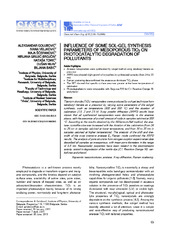Influence of some sol-gel synthesis parameters of mesoporous tio2 on photocatalytic degradation of pollutants
2016
Аутори
Golubović, AleksandarVeljković, Ivana
Scepanović, Maja

Grujić-Brojčin, Mirjana

Tomić, Nataša M.

Mijin, Dušan

Babić, Biljana M.
Чланак у часопису (Објављена верзија)
Метаподаци
Приказ свих података о документуАпстракт
Titanium dioxide (TiO2) nanopowders were produced by sol-gel technique from tetrabutyl titanate as a precursor by varying some parameters of the sol-gel synthesis, such as temperature (500 and 550 degrees C) and the duration of calcination (1.5, 2 and 2.5 h). X-ray powder diffraction (XRPD) results have shown that all synthesized nanopowders were dominantly in the anatase phase, with the presence of a small amount of rutile in samples calcined at 550 degrees C. According to the results obtained by the Williamson-Hall method, the anatase crystallite size was increased with the duration of the calcination (from 24 to 29 nm in samples calcined at lower temperature, and from 30 to 35 nm in samples calcined at higher temperature). The analysis of the shift and line-width of the most intensive anatase Eg Raman mode confirmed the XRPD results. The analysis of pore structure from nitrogen sorption experimental data described all samples as mesoporous, with mean pore diameters in the range of 5...-8 nm. Nanopowder properties have been related to the photocatalytic activity, tested in degradation of the textile dye (C.I. Reactive Orange 16), car-bofuran ray scattering.
Кључне речи:
nanostructures / anatase / X-ray diffraction / Raman scatteringИзвор:
Chemical Industry & Chemical Engineering Quarterly, 2016, 22, 1, 65-73Издавач:
- Savez hemijskih inženjera, Beograd
Финансирање / пројекти:
- SASA project [F-134]
- Наноструктурни мултифункционални материјали и нанокомпозити (RS-MESTD-Integrated and Interdisciplinary Research (IIR or III)-45018)
- Физика наноструктурних оксидних материјала и јако корелисаних система (RS-MESTD-Basic Research (BR or ON)-171032)
DOI: 10.2298/CICEQ150110020G
ISSN: 1451-9372
WoS: 000374140200009
Scopus: 2-s2.0-84962345388
Институција/група
Tehnološko-metalurški fakultetTY - JOUR AU - Golubović, Aleksandar AU - Veljković, Ivana AU - Scepanović, Maja AU - Grujić-Brojčin, Mirjana AU - Tomić, Nataša M. AU - Mijin, Dušan AU - Babić, Biljana M. PY - 2016 UR - http://TechnoRep.tmf.bg.ac.rs/handle/123456789/3436 AB - Titanium dioxide (TiO2) nanopowders were produced by sol-gel technique from tetrabutyl titanate as a precursor by varying some parameters of the sol-gel synthesis, such as temperature (500 and 550 degrees C) and the duration of calcination (1.5, 2 and 2.5 h). X-ray powder diffraction (XRPD) results have shown that all synthesized nanopowders were dominantly in the anatase phase, with the presence of a small amount of rutile in samples calcined at 550 degrees C. According to the results obtained by the Williamson-Hall method, the anatase crystallite size was increased with the duration of the calcination (from 24 to 29 nm in samples calcined at lower temperature, and from 30 to 35 nm in samples calcined at higher temperature). The analysis of the shift and line-width of the most intensive anatase Eg Raman mode confirmed the XRPD results. The analysis of pore structure from nitrogen sorption experimental data described all samples as mesoporous, with mean pore diameters in the range of 5-8 nm. Nanopowder properties have been related to the photocatalytic activity, tested in degradation of the textile dye (C.I. Reactive Orange 16), car-bofuran ray scattering. PB - Savez hemijskih inženjera, Beograd T2 - Chemical Industry & Chemical Engineering Quarterly T1 - Influence of some sol-gel synthesis parameters of mesoporous tio2 on photocatalytic degradation of pollutants EP - 73 IS - 1 SP - 65 VL - 22 DO - 10.2298/CICEQ150110020G ER -
@article{
author = "Golubović, Aleksandar and Veljković, Ivana and Scepanović, Maja and Grujić-Brojčin, Mirjana and Tomić, Nataša M. and Mijin, Dušan and Babić, Biljana M.",
year = "2016",
abstract = "Titanium dioxide (TiO2) nanopowders were produced by sol-gel technique from tetrabutyl titanate as a precursor by varying some parameters of the sol-gel synthesis, such as temperature (500 and 550 degrees C) and the duration of calcination (1.5, 2 and 2.5 h). X-ray powder diffraction (XRPD) results have shown that all synthesized nanopowders were dominantly in the anatase phase, with the presence of a small amount of rutile in samples calcined at 550 degrees C. According to the results obtained by the Williamson-Hall method, the anatase crystallite size was increased with the duration of the calcination (from 24 to 29 nm in samples calcined at lower temperature, and from 30 to 35 nm in samples calcined at higher temperature). The analysis of the shift and line-width of the most intensive anatase Eg Raman mode confirmed the XRPD results. The analysis of pore structure from nitrogen sorption experimental data described all samples as mesoporous, with mean pore diameters in the range of 5-8 nm. Nanopowder properties have been related to the photocatalytic activity, tested in degradation of the textile dye (C.I. Reactive Orange 16), car-bofuran ray scattering.",
publisher = "Savez hemijskih inženjera, Beograd",
journal = "Chemical Industry & Chemical Engineering Quarterly",
title = "Influence of some sol-gel synthesis parameters of mesoporous tio2 on photocatalytic degradation of pollutants",
pages = "73-65",
number = "1",
volume = "22",
doi = "10.2298/CICEQ150110020G"
}
Golubović, A., Veljković, I., Scepanović, M., Grujić-Brojčin, M., Tomić, N. M., Mijin, D.,& Babić, B. M.. (2016). Influence of some sol-gel synthesis parameters of mesoporous tio2 on photocatalytic degradation of pollutants. in Chemical Industry & Chemical Engineering Quarterly Savez hemijskih inženjera, Beograd., 22(1), 65-73. https://doi.org/10.2298/CICEQ150110020G
Golubović A, Veljković I, Scepanović M, Grujić-Brojčin M, Tomić NM, Mijin D, Babić BM. Influence of some sol-gel synthesis parameters of mesoporous tio2 on photocatalytic degradation of pollutants. in Chemical Industry & Chemical Engineering Quarterly. 2016;22(1):65-73. doi:10.2298/CICEQ150110020G .
Golubović, Aleksandar, Veljković, Ivana, Scepanović, Maja, Grujić-Brojčin, Mirjana, Tomić, Nataša M., Mijin, Dušan, Babić, Biljana M., "Influence of some sol-gel synthesis parameters of mesoporous tio2 on photocatalytic degradation of pollutants" in Chemical Industry & Chemical Engineering Quarterly, 22, no. 1 (2016):65-73, https://doi.org/10.2298/CICEQ150110020G . .


